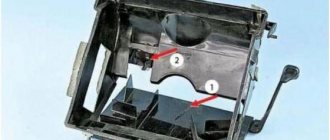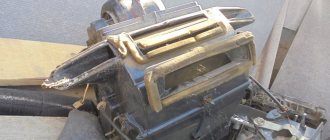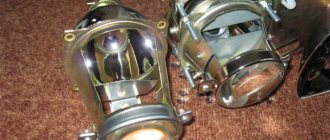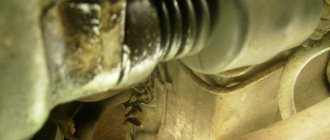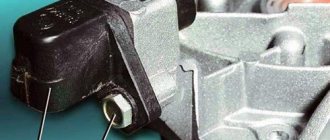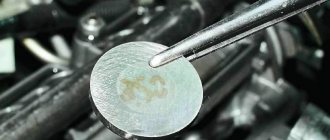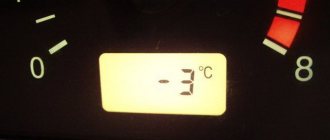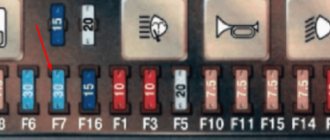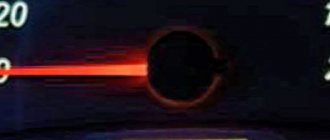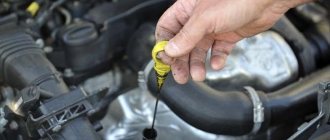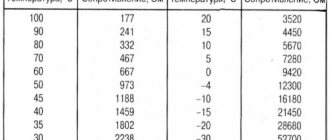good afternoon everyone. VAZ 2108 car, 2nd gear started to slip out, I’m sinning with the synchronizer. The synchronizer itself costs 300 rubles, but how much will it cost to repair it in a car service center? And how to avoid being spoiled? City of Samara. VAZ 2115 2nd gear slips out.
Similar articles
30 comments on “Vaz 2115 2nd gear slips out. 2nd gear started slipping out"
Fixator... the spring has sat down... I think it's about him
I was told all together 5-7 thousand. also most likely synchronous. Rostov
The 3rd VAZ 2113 took off, the repair cost 5500, labor and spare parts:) think for yourself) and it’s not a fact that it’s a lock) I also changed the clutches and synchronizers)
The problem is in the 1st-2nd gear clutch. Lately the 2nd with a crunch is ON.
Sin! Synchros have nothing to do with it, you can throw them away and drive without them! Clutch, fork, gear. one of three or all!
The synchronizer has nothing to do with it, it is only responsible for the smooth engagement of the gear. An autopsy will show. Also look at the cushion on the box, when I was 15 the cushion under the box tore, and it also knocked out gears when the engine rocked
In Samara, the boys themselves should be able to change this
The 2nd one also crashed on four, in the end the work cost 3 rubles, about 4 spare parts came out, synchronizers, bearings, gears, etc.
first change the retainer + pillows
Listen, you live near Kazakhstan, Ural, we are in the process of dismantling a new broken down car, you can buy a box for four rubles or make an old one for three
crashed on my eight. "new pillows" helped
Parsing everywhere in the city
Sergey, in Taganrog for 3.5 they made a kenta on the nine only the back
Dimon, well, I also talked about the second one
Sergey, it’s all about removing the gearbox and the synchronizer is crap, even the second one, even the rear one, remove it and put it on 3p
Dimon, I won’t argue) I don’t know) I’ll ask around again)
Hello, your clutch is screwed up and the 2nd gear may also be coming up, but you need to look at this, you can drive up, I’ll take a look, I’m at the satellite car service center
In Sochi 3.5 it costs to remove, reassemble and install back
In any case, disassemble the gearbox, then buy a set of bearings if you are going to shake it up. The first person will say thank you…..
To avoid getting screwed, do it yourself is the only surefire method.
They repaired the 3rd, on the 12th, 5t. R. Work + 3500 spare parts
Dima, your 2nd gear clutch has run out. There is a secret how to extend the life of a new clutch, and it will never fly out again
Evgeny, don't tear the box?
Dima, no, it will be possible to wind it up even more
Dima, because of the synchronizer, the transmission cannot take off, it only takes off due to licked teeth on the 3-4th gear clutch (or because of dinner with the ball, but this is a very rare case), due to a worn synchronizer, the gear either does not engage or is difficult to engage and with a crunch
It’s easier for you to disassemble the box and buy a new one!))
Causes
Unfortunately, it is possible to accurately determine the source of the problem only after disassembling the box. In case of such breakdowns, it is better not to use the machine until the problem is fixed. Failure to take this advice seriously may result in more complex and expensive repairs.
- The power unit supports are worn out
Let us list the characteristic features. The knot sways more than normal. The gearbox jumps and switches gears at its own whim. Under control with rigid rods, this happens more often (for example, VAZ 2109, VAZ 2110, VAZ 2114, Lada Priora and Kalina).
The second gear is strong, but it is not able to significantly reduce unnecessary vibrations. Broken bearings are not a big deal for a cable-controlled gearbox. Vibrations in soft cables are artificially suppressed (smoothed out).
In this case, the second gear takes off simultaneously with the fourth due to the coincidence of the direction of engagement (with different degrees of wear, such synchronization will not occur). In an “outdated” gear, dynamic jerks will be felt much more strongly.
What to do? Change the supports immediately so that you don’t have to change the entire box later. The unit may suffer due to torn elements:
- tubes;
- hoses;
- cables;
- wiring harnesses.
There are a lot of flagella connecting the manual transmission with other components of the car, so the damage can be significant.
- Drive mechanism wear
An unadjusted or outdated drive prevents you from engaging the gear “full”. This way the gear easily falls out, especially when coasting (the motor spins the wheels, the clutch teeth mesh better than when the engine is braking).
Check the hinges going from the levers to the cables. Their failure leads to a drop in speed.
There is an opinion that the clutch can cause the transmission to fly out. If you don’t squeeze it enough, you really run the risk of partially engaging the gear, but this cannot be classified as “knocking out”.
- The teeth in the couplings are worn out
An indirect sign by which this problem can be identified: spontaneous gear disengagement during sudden acceleration or braking.
The reason for the wear of the part is a breakdown of the clutch drive mechanism (there is no “out of sync” between the internal combustion engine flywheel and the gearbox input shaft).
- The synchronizer flew
This failure has the following reasons:
- the springs have weakened (it can only be checked by completely disassembling the box);
- the forks are worn out (the shafts may have a lot of play along the axis, then the forks do not completely disengage the clutches);
- The speed selection mechanism has become dilapidated.
For those with automatic
If your car has an automatic transmission. It will not hurt you to know the modes in which your machine can operate:
- P – For parking and starting the engine. Switching to this mode is possible only after the machine has completely stopped.
- R – To move backwards. Switching to this mode is also possible only after stopping the car and with the brake pedal pressed.
- N – Neutral. When the engine is completely disconnected from the gearbox.
- D – Moving forward without restrictions on gear shifting (the most commonly used operating mode of the automatic transmission).
- D3(S) – Low gears for climbing and braking engines on descents.
- D2 – Mode for difficult conditions (slippery or mountainous roads). Gears above second are not shifted, that is, only first and second gears are engaged.
- D1(L) - Movement occurs only in 1st gear, used off-road on mud, snow or ice, where you need to drive without changing the throttle, and also to overcome steep climbs.
The automatic transmission also has a button on the mode shift lever with the inscription O/D OFF. When it is turned on, the inclusion is prohibited, increasing the gears of the analogue of the 5th gear of the manual transmission. That is, if your automatic machine has 4 gears for moving forward, then for more dynamic acceleration it will use only three lower gears.
About a faulty automatic transmission, an automatic transmission is much more complex than those encountered with a manual transmission, and the chances of repairing it in your garage are slim. But despite this, you still need to know something about it, if only in order not to harm it through improper use.
An automatic transmission is much more demanding in terms of accuracy in maintaining the oil level in it than a manual transmission. Both too low and too high oil levels are very harmful to her. Both of these can lead to serious damage. In both cases, oil foaming occurs. When there is a lack of oil due to the fact that the oil pump begins to capture air along with the oil. When there is excess oil, it foams on the rotating parts, which in this case are immersed in it. Foamed oil compresses better and has low thermal conductivity. Therefore, if you operate a machine with such oil, the pressure in its control systems will be low. Which will lead to slipping of the clutches and their intensive wear. Deteriorated thermal conductivity will not allow all excess heat to be removed. Which, together with low pressure, will lead to the machine failing and requiring serious repairs.
Causes
The reasons why reverse gear engagement is poor or difficult may be as follows:
- loosening of the fastening clamp of the rocker, due to which the length of the rod is not enough to fully engage the gear;
- jamming of the reverse speed lock;
- spring breakage and debris getting into the guide grooves of the gear selection mechanism;
- spontaneous loosening of the selection mechanism mounting bolts;
- the clamp bolt is cut off;
- wear of the clutch disc and release bearing;
- incorrect adjustment of the clutch and clutch pedal;
- low oil level in the box or the need to replace it.
Causes and solution to the problem of unstable engagement of first gear on Priora
Author:VAZ Priora cars have replaced the flagships of the domestic manufacturer. Recently, more and more adherents of Russian cars are switching to Priora. But in these vehicles, as in any other, certain malfunctions may occur, especially when it comes to. Today you will find out why the Priora is bad and how to fix this problem. Contents [ Expand ] [ Hide ] The gearbox of any car is one of the most important units of the vehicle.
Breakdowns in it can occur both due to improper operation and due to driving on bad roads. If the first gear on your Priora does not engage well or does not engage at all, then this is due to a breakdown of the gearbox. If your car was purchased second-hand and not from the showroom, then there is nothing to be surprised about.
Why reverse gear does not engage (or is difficult to engage) on LADA
23 838 Reverse gear rarely engages the first time, and the process itself is accompanied by a crunching sound?
In any car, sooner or later the problem of unstable gear shifting may arise.
Owners of not only Lada Priora, Kalina and Grant models, but also modern Lada Vesta and XRAY cars face similar problems. Let us tell you what is the cause of this disease. The peculiarity of the reverse gear on LADA cars is that it does not have synchronizers. Therefore, the problem of engaging reverse speed is most often due to the fact that the gear gets caught on a tooth.
What to do if reverse gear does not engage: If you feel that the reverse gear has not reached, release the clutch a little, the gear will move and the gearshift lever will be inserted all the way. After releasing the clutch, try to engage reverse gear after 2-3 seconds.
Try depressing the clutch and putting it in neutral, then releasing the clutch, and then again depressing and engaging the reverse. Try engaging reverse gear at a different speed.
Why does second gear slip out?
A manual transmission is more reliable than other types due to the lack of electronic brains. However, manual transmissions also have their own “diseases,” one of which is gear slippage. It is not difficult to determine the breakdown. The main features are as follows:
the control lever goes into neutral on its own (without your participation).
When you try to engage the transmission again, the failure repeats. To keep the lever in the desired position “at speed”, you will need to constantly hold it with your hand.
We recommend that you immediately contact a car service center, where they will fix the problem for you.
Modern multi-speed gearboxes allow you to get to your destination by eliminating one gear.
Troubleshooting
Many transmission malfunctions that cause the reverse gear to disappear or fall out can be eliminated without removing the unit from the car.
If the cause is a loosening of the bolt securing the clamp on the rod, then to correct the defect it is necessary:
- Place the car on a lift.
- Completely loosen the clamp nut.
- Place the gearshift lever in the fully engaged reverse gear position.
- Fully engage reverse gear at the gearbox using the shift rod on the crankcase.
- Tighten the clamp mounting bolt.
Backstage adjustment
If tightening the clamp does not help get rid of the problem, then you need to check the condition of the shift drive parts. One of the reasons why the reverse gear does not engage may be a poorly adjusted rocker.
To make adjustments to the mechanism, you may need the following tools:
- two wrenches with a size of 13 mm, preferably a socket design;
- any wrench or 10 mm socket;
- small hammer;
- slotted screwdriver.
Since the cause of malfunction of the link can be wear of parts, spare parts may be needed:
- universal joint of the rocker;
- Sometimes the shift rod seal may need to be replaced.
Two people are required to adjust the rocker or replace parts of its drive. One person must change gears from the passenger compartment, and the second must adjust the travel of the shift rods.
The order of work is as follows:
- Provide access to the bottom of the car by placing it on a pit or a lift.
- Using a 13 mm wrench, loosen the clamp installed on the gear shift rod.
- Remove the rod from the box rod.
- Using a screwdriver, carefully remove the boot.
- Using a 10 mm wrench, unscrew the fixing bolt on the cardan shaft.
- Knock off the cardan shaft with light blows of a hammer. It is important not to damage the shaft.
- Remove the universal joint seal boot.
- If there is an oil leak, the sealing gland on the box rod must be replaced.
- Install a new boot (or leave the old one if it is intact) and install the universal joint on the shaft.
- Align the hole on the cardan with the notch on the shaft.
- Tighten the 10 mm clamp and install the boot completely in place.
- Install the rod on the cardan rod and adjust the gearshift lever travel.
- The second person should sit in the driver's seat, set the gear shift lever to neutral, move it slightly to the right and hold it in that position.
- After this, you need to tighten the 13 mm clamp nut.
Typically, after such a repair, the reverse gear starts to engage without problems. In addition, the operation of the entire gear selection mechanism on the VAZ-2109 becomes clearer.
Replacing the backstage
Changing the gearbox oil
If the oil seal on the rod is damaged, oil leaks out of the gearbox housing, and dirt can get into the box itself. These factors may be the reason why reverse gear stops engaging. In addition, the oil in the box loses its properties during operation, so it must be replaced preventively at least once every 35–40 thousand kilometers. Before replacing, you need to check the condition of the oil in the box. To do this, you need to remove the oil dipstick installed in the gearbox housing and visually assess the quality of the oil. The presence of metal and dirt particles in the oil on the dipstick is unacceptable. The oil itself should be quite liquid and not stick to your hands in a thick layer.
Dipstick with oil level marks
To replace, you will need the following materials and tools:
- New oil. When purchasing oil, you need to consider the type of gearbox. For fairly rare four-speed gearboxes, three liters of oil are required, for newer five-speed ones - 3.3 liters. The oil itself must have a tolerance of 80W-85, the manufacturer does not matter.
- A container for draining old oil with a volume of at least 4 liters.
- A funnel with a hose for pouring new oil or a syringe.
- Wrenches 12 and 17 mm of any type.
- Rags and cleaning solvent.
The actual work order is as follows:
- Place the car with the heated gearbox on the pit.
- Remove the rubber plug from the gearbox ventilation valve installed on the top of the crankcase.
- Clean the valve and plug from dust and dirt. It is convenient to clean parts with thin wire and a rag.
- Reinstall clean parts.
- Wipe off dirt from the bottom of the box. Unscrew the plug on the bottom of the box housing.
- Place a container under the drain hole and drain the oil. It will completely merge in at least 20-25 minutes.
- After this, screw the drain plug back into place and carefully tighten it with a wrench. First, the plug and hole must be thoroughly wiped with a rag.
- Pour fresh oil through the oil level dipstick hole in the box.
- During filling, it is necessary to check the oil level, which normally should be between o and “MAX” on the dipstick rod.
- If there is an overflow, the oil can be pumped out with a large medical syringe with a tube on the spout.
- Within a few days after the change, it is advisable to check the level and appearance of the oil. You also need to make sure that there are no leaks through the plug and box seals.
Rubber cap for crankcase ventilation
Drain hole on the crankcase
Dipstick at the top of the crankcase
A funnel for filling oil installed in the dipstick hole
Transmissions are not included. Appears when the engine is running - the main problems
As you already understand, we will talk specifically about a manual “box” and about shifting gears (or rather, not shifting) on it. I have quite a lot of experience in this area; I personally repaired cars such as VAZ 2114, VAZ 2110 (and the 10th family in general). To say that there are global differences between foreign cars, there really aren’t any! So if your speed is not cut off, then the reasons may be similar. In general, the article will be useful, at the end, as usual, there is a video...
THE CONTENT OF THE ARTICLE
A fairly large number of such questions come to me, especially from novice drivers of our VAZs! Especially with front-wheel drive, because in rear-wheel drive cars the lever was installed in the manual transmission itself. I want to answer everyone right away - the problem of non-inclusion may not always be cardinal! Often it’s a small matter, something just got loose or unscrewed from time to time, as a rule, this happens in 50% of cases.
Therefore, I will try to break the material into two large components - simple and complex faults.
I suggest starting with simple faults.
Replacing the bearings of the primary and secondary shaft of a VAZ 2110
Replacing the bearings of the primary and secondary shaft on a VAZ 2110 occurs in the following cases:
It is important to know: If you do not pay attention to the above listed signs of malfunction of this part, in the future you will not be able to do without serious repairs to the clutch or gearbox. By changing the gearbox shaft bearings in a timely manner, you can avoid unwanted problems and additional cash costs for repairs.
Replacing the bearing of the primary and secondary shaft on a VAZ 2110 - step-by-step instructions
Often, descriptions of the steps for replacing a bearing indicate that this requires completely disassembling the gearbox, but in practice it is usually enough to remove the casing from the gearbox. Of course, before this you will have to dismantle the mechanical box:
- disconnect the battery terminals;
- remove all chips from the body;
- unscrew the speedometer drive;
- remove the “pants” of the exhaust removal system;
- remove the box from its place.
The case often turns out to be heavily contaminated with road dust - it is advisable to remove all this dirt and then remove the bell from the box.
The bearing is usually secured using a set of retaining rings, which can be removed by simply pressing a screwdriver. It is convenient to remove the rings from their place using tweezers. After this, insert the tip of a screwdriver into the annular groove of the bearing and move the input shaft forward.
The process of replacing the bearings of the primary and secondary shaft on the VAZ 2110 gearbox
The new bearing must be lubricated with engine oil, then put on the shaft and just as carefully pressed in, lightly hitting it with a hammer in a uniform rhythm in a circle. After pressing, make sure that the bearing is level, rotates freely, without runout. After this, you can reassemble the box by installing all the removed parts in the reverse order.
Video: Instructions for replacing the bearings of the primary and secondary shaft on a VAZ 2110 with your own hands
Features of foreign cars using the example of some brands
In a Mercedes Adego, among other things, failure of the second gear can be caused by a failure of the rocker (especially with a mileage of 200 thousand km). Then there are two options for the development of events:
- it is necessary to replace the scenes (if there is a lot of play);
- repair is possible (when the “play” is weak).
If the gear is engaged without resistance and unnecessary sounds, but it is necessary to keep the second gear from “flying out,” the reason may lie in the synchronizer retaining ring. In this case, you will have to disassemble the gearbox.
For Chevrolet Lanos, problems with second gear, judging by reviews from car owners, are more common after 100 thousand miles on a “cold” car. A common cause is pin and rod wear.
Finding a convenient auto repair shop that you can trust to repair your second gear is easy at Uremont.com. To do this you will need to do the following:
- make a request (if you cannot drive with a failed transmission, you can even call a tow truck);
- after the responses arrive (within 10 minutes), you can evaluate potential performers (see the ratings and reviews of portal users);
- Questions about price can either be indicated immediately in the application or asked in a special chat (representatives of partner car services will answer you).
When and how often do you need to repair the gearbox on a VAZ 2107?
(“Volzhsky Automobile Plant”) provides comprehensive information on when and how often the gearbox needs to be repaired. It turns out that this mechanism does not have a service life as such. The only thing AvtoVAZ engineers insist on is the timely replacement of transmission oil:
- After the first 2 thousand kilometers on a new car.
- After 60 thousand kilometers.
- Further, as necessary, depending on the care of the owner and the frequency of use of the car.
Accordingly, the plant does not have any specific wishes or requirements for preventive or repair work. However, in any case, regardless of the mileage, it is necessary to carefully monitor all the nuances in the “behavior” of the box, since repairs will be necessary if the slightest malfunction occurs.
VAZ 2114 1-2 gear crunch
Moderator: Kolya Taran
VAZ 2114 1-2 gear crunch
RaF » June 19, 2021, 11:07 pm
HELLO! In general, the situation is like this: the 2nd gear crunched (and constantly crashed) and the rear gear when you switched. disassembled the box: changed the 2nd gear synchronizers, changed the release lever, changed 2 cushions at the gearbox on the left and the far support (HZ as they are called)
Well, little by little, the magnet has been cleared of chips. The oil was left the same, because it is light/clean and the car is new, it has run about 70 thousand. Not even a week later, the crunching noise repeated itself (as soon as we got to Kazan) In general, the rear one turns on without a crunching sound when you stop normally (wait a few seconds), squeeze the clutch and carefully shift. and in general there is a crunching noise when switching. The second gear - it’s unclear how it crunches, when you start to accelerate, you shift, it crunches like a knife to the heart, and sometimes it’s normal, the impression is that it managed to shift during the shift (it got into revs) there will be no crunch. all other transmissions are normal! what to do where to dance? Should I take the box off again? Threat, what do I remember from the last checkpoint analysis. on the 2nd gear gear, the corners of the teeth seem to be worn out by 1-2mm, I don’t know whether they (the corners of the gears) should be sharp or blocked, there are no such gears on our collective farm, just when we took the synchro, they showed the gear in the store, the seller said don’t mess with it the brain is a normal gear! PS PS, sorry for describing it in detail, I’ve never climbed into boxes and don’t know how it works.
Re: VAZ 2114 1-2 gear crunch
» June 19, 2021, 11:20 pm
Re: VAZ 2114 1-2 gear crunch
RaF » June 19, 2021, 11:36 pm
Re: VAZ 2114 1-2 gear crunch
» June 19, 2021, 11:49 pm
Evonokak)) to start playing with the pedal then. Isn't the link short-stroke by any chance? Did you remember to put a stopper on the 1-2 gear hub? Are the balls and springs all in place? Did you disassemble the 1st-2nd gear clutch or did you remove the entire assembly? If you took it apart, was it reassembled correctly? But in theory, if it worked, then most likely it was correct. Did you remember to put a thick washer under 5th gear? Did you put retaining rings on the bearings? I don't know what else to guess. With this mileage I would change the oil better. And I adjusted the clutch. And then crawl into the box.
Read more: Baic e series ev 200
Added after 1 minute 27 seconds: Do the gears turn on in the end? Or do they just crunch and not turn on?
Re: VAZ 2114 1-2 gear crunch
RaF » June 20, 2021, 00:19
The slide may be standard, I didn’t pay attention.
play with the pedal? what does it mean - 1 cm below the brake pedal, then ride - align with the brake pedal - ride above the brake pedal, set to 1 cm. Is that what you mean?
The stoppers were all in place, the balls and springs were all in place. But there was a problem with the thick puck, I remember exactly that we didn’t know where to put it, where did it end up? ))) I do not remember.
And all the gears are engaged without exception, just 2nd and Rear with a crunch. but when you stand still, squeeze the clutch and carefully engage the rear one, there is no crunch, the same with the second one.
Re: VAZ 2114 1-2 gear crunch
» 20 Jun 2021, 08:05
Well, the rear with a crunch is still tolerable. Even on fully functional boxes it sometimes turns on with a crunch. It doesn't have a synchronizer. Somehow I changed the clutch on a grant. After that, the rear one also began to turn on with a crunch. Adjusting the cable helped. The crunch has almost disappeared. By the way, if you turn on the rear one through the first one, it doesn’t crunch)) But the second one does. does it crunch and turn on and not fly out on its own? When you bought the spare parts, weren’t they confusing the 08 with 10 gears? There are also old and new models. Carefully inspect the removed parts. I trained here two weeks ago with my little girl. The first one didn't turn on. After the sixth removal/installation I was only able to find out the reason. Everything was changed related to 1-2 gears, but spare parts are junk these days. There was too much axial play at the hub with the coupling. Well, either you collected everything normally. It’s just that the owner tears the box and again damaged the second gear synchro. Are there any extraneous noises from the gearbox?
Added after 41 seconds: And remember about the puck.
Re: VAZ 2114 1-2 gear crunch
RaF » June 20, 2021, 08:48
Re: VAZ 2114 1-2 gear crunch
Trid43 » June 20, 2021, 09:37
Re: VAZ 2114 1-2 gear crunch
RaF » June 20, 2021, 10:21 pm
Re: VAZ 2114 1-2 gear crunch
RaF » June 24, 2021, 10:36 pm
So, I split the box, took a photo of the clutch and the 2nd gear. Evaluate and give a verdict, is it because of the gears or the clutch or something else? The box is now disassembled. Tomorrow we need to think about going and buying something. Damn the photos didn’t upload, I’ll get to the laptop right now
Added after 1 hour 47 minutes 41 second: the photo can be enlarged by clicking on it or downloaded to your computer and taken a closer look
Added after 9 minutes 15 seconds: wear is visible on the gear! I called a friend from the service center, came and took a quick look, and said that the teeth were sweating partly due to a crappy clutch. could it be like this? And in general, is this wear so critical?
Re: VAZ 2114 1-2 gear crunch
» 24 Jun 2021, 22:59
Even from my phone I can’t make out what the crap is in the second photo? The basket doesn't seem to be very worn. I wish I could take a larger photo of the clutch disc. On the fifth (from the top) photo is the secondary shaft. Why did they take it apart? There, the first and second gears on the other side are disassembled. And yet in this photo the second gear gear is upside down. Or was this done specifically for the photo? Or I can't see well on my phone. Are you sure the components weren't mixed up? There are old and new samples and 08 and 10.
Read more: Is it necessary to remove the plugs when charging the battery?
Added after 1 minute 13 seconds: Where was the thick washer?)) From fifth gear which.
Re: VAZ 2114 1-2 gear crunch
RaF » June 24, 2021, 11:24 pm
in the fourth photo these rings are under the 2nd gear gear, so to speak, inside the next gear
Added after 2 minutes 11 seconds:
Re: VAZ 2114 1-2 gear crunch
» June 24, 2021, 11:26 pm
Re: VAZ 2114 1-2 gear crunch
RaF » June 24, 2021, 11:28 pm
ummm, I didn’t turn anything over in the photo, I took a photo of how they stand on the shaft. and then removed it from the shaft
Added after 1 minute 17 seconds:
Re: VAZ 2114 1-2 gear crunch
» June 24, 2021, 11:41 pm
The shaft that cannot be disassembled and sticks out of the box is called the primary shaft. And the shaft from which the gears are removed is a secondary one.
Added after 2 minutes 11 seconds: Unfortunately, I haven’t climbed into boxes younger than 10-11 years old. Haven't they really made such changes to the details? ((
Added after 4 minutes 25 seconds: Photo with title on h-KRO. It has a secondary shaft located in the gearbox housing. The bottom gear is first gear. Above is the 1-2 gear clutch. The second gear gear is even higher. This gear should be the other way around. I’ll get to the laptop now and take a closer look.
Added after 5 minutes 28 seconds: Got there. I looked. I don't recognize the detail. I went to study the manuals for the Kalina gearbox.
I’ll say right away that this is not synchronous, although the sound is similar. The likelihood that this is synchronous is very small. Because I let the secondary shaft slow down before engaging second gear. It all started with a slip in a snowdrift. It fell through in second gear and stalled. The clutch is scorched, but the rest engage normally, the rear one sometimes with a crunch. It also crunches in place, video on YouTube is attached. I waited 5 seconds and turned it on softly, etc. It still crunches. It doesn't crunch only when the box is cold. And that's not always the case. YouTube link:
Because You are not logged in. To come in.
Because you are not a trusted user (phone number is not verified). Enter and confirm your phone number. Read more about trusts.
Because The topic is archived.
2114) does not provide such freedom as the UAZ. besides, confidence on the road costs a lot.))) ¶
( 1 rating, average 5 out of 5 )
- Thank you
- I do not like
ValinoG 21 Dec 2007
I engage 2nd gear, just press the gas and find myself in neutral. To go into 2nd you have to hold the shift knob all the time. What died in the box? Can you drive for a long time with such a jamb?
you either have a broken gear lock or fork 1; 2nd gear was worn out and 2nd gear seemed to be not engaged, which is why it crashed
Special cases
Second gear is not detected.
When you start the car, noise comes from the gearbox and you hear crunching noises.
- the fifth gear or reverse gear has failed;
- The release bearing or the input shaft bearing is faulty.
Any transmission fails.
When driving at 9, there is a hum, when I press the clutch the hum does not stop. What's humming, bearings?
Hello everyone, help me, on 09, speed 2 stuck and won’t let go, what should I do? but we already sorted it out, now it’s set to 3 speed again, what should I do?
Possibly a bearing. Soon he’s still walking freely along the shaft. The shaft must be together with the internal part of the bearing. spin, and he rotates freely in it. It is also likely that this is the reason for the rumble.
I have a similar situation. I went through the box twice. I changed all the bearings, but the noise never went away. I'm already starting to get used to it.
The situation is exactly like this, it’s like my car in the video. Most likely you need to make a mistake in 5th gear, the only question is how to check. But one idea has appeared, you can remove the 5th gear cover, open two nuts, remove the 5th gear gears, close the cover, add oil, and then everything will be clear. I’m thinking about doing this one of these days. Report the results.
I checked the gearbox twice, but the second speed doesn’t turn on, I don’t know what to do. Please tell me!
Do not remove the 3.4 gear synchronizer hub. What to do? I read somewhere that you just have to film. And she sits there like a cast woman.
Sergey, check the release and clutch
The rear one flies out, I can’t figure out what’s wrong
The speed slips due to wear of the synchronizer (teeth on bronze gears).
I have this problem: there are 2 washers on the secondary shaft, one is a little thicker, the other is thinner, can anyone tell me which one comes first in order during assembly?
the thin one is placed under the bearing, the thick one is on top, there is a bushing and a needle on it
Why does the second speed turn on poorly? The rest work well and don’t make noise.
The situation is this: you squeeze the clutch, the noise disappears, the reverse speed does not work as well, when driving the noise does not disappear, what could be the reasons?
The third and fourth gears are poorly engaged
Tell me. Impact at start, as if there were huge gaps between the gears. The grenades are ok, I replaced the airbags, I also changed the satellite axle along with them and the six-pole axle, I replaced the clutch assembly. They say: sampling of backlashes and the box on metal. Can the problem be solved somehow?
This situation occurred when there was a blow to the gearbox body of the VAZ 2109. The 2nd and 4th gears stopped turning on and the idle speed stopped. What could happen? With the car turned off, all gears are switched on
Help! There is no neutral gear, what's the fun?
The problem is this: 2nd gear slips out when you let off the gas on the VAZ 21101, what could it be? Can I change the gear shift rod lock balls?
I can’t turn on the rear, the lever on the shaft turns, what can I do?
Mikhail, this is a disease, this is synchronicity!
I switched from first gear to second and can’t turn it off, what could be wrong?
Release bearing or input shaft bearing. Check the reverse gear
In the VAZ 2109, the second gear shifts into gear all the time with a crunch, you can only turn it on slowly, what should you do about it? And the clutch began to disappear.
There is a noise in the transmission as if the high-speed sprockets are hitting each other when driving in neutral and when pressing the clutch, what could be?
At first the rear one turned on poorly, but now only the third and fourth ones turn on. What should I do?
Guys, I ran into this problem. 2nd speed went out, changed the primary and secondary shafts along with gears. Everything worked well until the gearbox was removed and the release was replaced. I collected everything, drove about 300 kilometers, and the noise started. It looked like it was on the release side, he figured it out okay. Tell me what this could be? And yet, the right CV joint begins to rotate at increased speeds.
There is no reverse gear, tell me what to do and how much does it cost?
We've gone through the gearbox and the gears won't turn on!
Second gear does not engage
Hello! Tell me, the noise in neutral, types 1, 2, 3 squeak, types 4 and 5 howl. But sometimes without load everything is OK, they don’t knock out, they turn on well. What should I change? Thank you. PS And when you squeeze the clutch there is silence.
All the speeds are flying out, what should I do?
I installed row 18 on a VAZ 2113. Everything is new, but 3rd gear started jumping out, and it jumps out when you let off the gas. The lever comes off, but if you hold it, the car drives normally.
The article describes what problems most often occur with the model. Recommendations for eliminating them are also given. If you are the owner of a GAZ 3110, we advise you to read it - you will definitely find something useful.
This article describes: the signs characteristic of increased and decreased valve clearances, and two ways to adjust them. After reading this article, you will know exactly when and how to adjust the GAZ 53 valves.
This article explains what problems you may encounter and how to fix them, how to change the oil in the garage. In addition, you will receive advice on which checkpoint to give preference.
Any gearbox has a complex structure with many interconnected parts, and the failure of even one part immediately affects the performance of the gearbox as a whole.
Clutch fork
It’s rare, but it happens, for example, I had such a problem once on a VAZ 2105; the fork itself that retracted the clutch disc broke. Apparently it was not of very good quality. Why am I writing this down as a complex problem, because in order to replace it, you often need to remove the entire box, and this is no longer easy! Especially on front wheel drive. ALTHOUGH now people's “masters” in garages change it without removing the manual transmission.
Release bearing
The clutch fork is connected to the release bearing; it is this bearing (under the influence of the fork and your foot) that presses the clutch petals and disconnects the disc from the flywheel and basket. If the bearing is “covered”, then this process becomes very difficult. To be fair, it is worth noting that the gears will still be switched on, but it will be very difficult! With crunching, whistling and other jokes. It's worth changing it. However, again you will need to remove the transmission
- Thank you
- I do not like
Shuron Dec 21, 2007
The integrity of the retainer can be checked without removing the gearbox. To do this, you need to unscrew such a small cap (a rectangular piece of metal) on two bolts, under it there will be 3 holes. In each of them there is a ball and a spring, this cap presses on the springs, the springs on the balls, and they fit into the recesses on the shaft on which the forks are fixed and fix the shaft in the desired position. This is an old-style gearbox, previously installed on the ninth family. On the tenth they began to install a slightly different design - there is no this cap, but there are springs and balls, now each spring is held in place by crap like a bolt. Those. It all looks like 3 bolt heads located along the same line not far from each other. You can carefully unscrew the bolt and check the condition of the spring and ball. All this equipment is located at the bottom of the box, the suspension rod (stretch) runs nearby, the bolt heads look down and forward. When unscrewing, oil will leak and the contents will fall out. Alternatively, see if anything is preventing you from engaging 2nd gear in the area of the lever itself, under the cover. Other options entail disassembling the gearbox.
Let's look at the springs with balls. I looked under the cover and there is nothing in the way. Has anyone removed the box themselves in the garage, is it a pain in the ass?
Replacing oil seals
Most often, gaskets and seals are subject to wear. And if the gasket can be changed even by an inexperienced driver, then the replacement of oil seals should be treated with the utmost care.
By its design, the oil seal is a rubber gasket that acts as a sealant. That is, if the oil seal breaks or wears out, the box ceases to be sealed, which, in turn, leads to oil leaks and breakdowns.
The oil seal in the VAZ 2107 gearbox is not made of rubber alloys, as most drivers think. In fact, the product is made of special composite materials, which are much more durable than rubber and less susceptible to tearing. In its working condition (that is, constantly), the oil seal is in the transmission oil, so its elasticity remains for a very long time.
In order to restore the tightness of the gearbox, you will need to change this gasket. To work you will need:
- new oil seal from the same manufacturer;
- spanners;
- hammer;
- screwdriver with a flat thin blade;
- sealant.
Input shaft oil seal
The VAZ 2107 gearbox input shaft oil seal has the following performance characteristics:
- weight - 0.020 kg;
- dimensions - 28x47x8 mm;
- location - on the input shaft in the clutch housing.
Accordingly, in order to replace the gearbox input shaft oil seal, you will need to remove the gearbox from the car and disassemble the casing:
- Remove the bell (casing) from the box; it is secured with four bolts.
- Remove the fork and release bearing from the box (the fork is secured with screws, the bearing will have to either be knocked out with a hammer or pressed out with a vice).
- Access to the input shaft and its oil seal is provided.
- Using the blade of a knife or screwdriver, pry up the old ring and remove it from the shaft.
- It is good to clean the seal area from dust and dirt.
- Install a new oil seal.
- Reassemble the gearbox in reverse order.
The bell can be easily removed, as it is attached with only 4 bolts. It is important to very carefully pick up the oil seal without scratching adjacent surfaces. Even if the old oil seal does not have cracks or deformations, when disassembling the gearbox, it still needs to be replaced with a new one.
The work of replacing the input shaft oil seal is not particularly hassle.
Secondary shaft oil seal
The secondary shaft oil seal differs slightly in its characteristics from the input shaft gasket:
- weight - 0.028 kg;
- dimensions - 55x55x10 mm;
- operating temperature range - from -45 to +130 degrees;
- location - on the secondary shaft at the flange junction.
The oil seal is replaced with the gearbox removed:
- The first step is to firmly fix the flange of the box; you can insert a bolt or a thick screwdriver into it.
- Turn the flange fastening nut with a wrench.
- Using a screwdriver, pry up the centering metal ring and pull it out from the secondary shaft.
- Remove the bolt from the hole.
- Place the puller against the end of the secondary shaft.
- Remove the flange along with the washer.
- Using screwdrivers or pliers, remove the old oil seal from the box.
- Clean the joint and install a new oil seal.
Thus, replacing the secondary shaft oil seal is somewhat more difficult than doing the same job on the input shaft. The difference is due to the location of the seals and their dimensions.
Photo gallery: main stages of work
For work, you need to choose the thickest and most powerful screwdriver or bolt so that they do not bend The flange can only be removed using a puller The landing site must be cleaned of dust and dirt
Synchronizers
If, when the engine is running, you do not engage gears, or shifts occur with VERY great effort and CRUNCHING! Then there may be a problem with the manual transmission synchronizers. Without going too deep, these are soft gears (usually brass or copper) that synchronize the shafts for soft and fast shifting. If they wear out, then shifting may disappear altogether! In general, we are definitely changing.
- Thank you
- I do not like
Yoholot 04 Jan 2008
If you have the money, in my opinion it’s better to install a new one. The spare parts are of poor quality, you can’t do it yourself anyway, but there’s less hassle. And you’ll tear up the old one, maybe change something, and then either sell it or install it. But I don’t think cold welding is good.
A new box - the same spare part (rejected at the factory or assembled from stolen parts in a neighboring garage) - may not be the best copy. The advantage of doing your own repairs is that you can then drive this gearbox with confidence and not expect a “surprise” from it; besides, you can install the “necessary” shafts, change the gear ratios, etc. whatever your heart desires. As far as I remember, the second gear initially fell out - what to do with cold welding. ? or apply it to a broken clutch basket? What does it have to do with it? If you have no options to do it completely, then of course you can have a new gearbox (since I wouldn’t trust the bulkhead to anyone, only myself).
How to replace gears and synchronizers
The gearbox on the VAZ 2107 is a complex device. Therefore, if you do not have confidence in your abilities, it is better not to start replacing gears, but to turn to specialists for this service.
However, if you decide to replace worn out gears and synchronizers yourself, you will need to prepare the necessary tools in advance and buy a repair kit for replacement.
The standard repair kit for gearbox shafts 2107 usually includes gears, synchronizers, washers, a pin, nuts and bolts.
To work you will need:
- vice;
- puller;
- screwdriver with a thin flat blade;
Replacing gears and synchronizers on the primary, secondary or intermediate shafts is generally carried out according to the same scheme:
- Remove the shaft from the box.
- Clamp the shaft in a vice (it is important to wrap the jaws of the vice with a soft cloth so that they do not damage the surface of the shaft during operation).
- Use a screwdriver to pry up the shaft retaining ring and remove it.
- Press out all bearings.
- Unclench the vice and rest the first gear on two supports.
- Compress the gear by gently hitting it with a hammer.
- Perform the same actions for all subsequent gears and synchronizers.
Video: instructions for removing gears from the shaft
During operation, it is necessary to carefully inspect the shaft. Between the gears there may be clamps, retaining rings and other small parts. They must be removed without fail, otherwise it will be impossible to remove the gear.
Accordingly, the installation of new elements occurs in the reverse order.
Thus, repairing a gearbox on a VAZ 2107 cannot be called a simple task. The driver needs not only to exert maximum physical effort, but also to act extremely carefully so as not to damage the shaft and its elements. If you are unsure of your abilities, it is better to contact a car service specialist.
